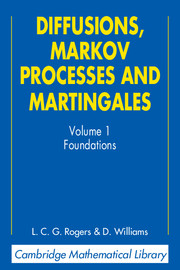CHAPTER I - BROWNIAN MOTION
Published online by Cambridge University Press: 05 February 2014
Summary
1. What is Brownian motion, and why study it? The first thing is to define Brownian motion. We assume given some probability triple (Ω, F, P).
(1.1) DEFINITION. A real-valued stochastic process {Bt,:t∈R+} is a Brownian motion if it has the properties
(1.2) (i) B0(ω) = 0, ∀ω
(1.2) (ii) the map t ↦ Bt(ω) is a continuous function of t∈R+ for all ω
(1.2)(iii) for every t,h ≥ 0, Bt+h, – Bt, is independent of {Bu: 0 ≤ u ≤ t}, and has a Gaussian distribution with mean 0 and variance h.
The conditions (1.2)(ii) and (1.2)(iii) are the really essential ones; if B = {Bt: t∈R+} is a Brownian motion, we frequently speak of {ξ + Bt,:t∈R+} as a Brownian motion (started at ξ); the starting point ξ, can be a fixed real, or a random variable independent of B.
Now that we know what a Brownian motion is, questions of existence and uniqueness (answered in Section 6) are less important than an answer to the second question of the title, ‘Why study it?’ There are many answers to this question, but to us there seem to be four main ones:
(i) Virtually every interesting class of processes contains Brownian motion—Brownian motion is a martingale, a Gaussian process, a Markov process, a diffusion, a Lévy process,…;
(ii) Brownian motion is sufficiently concrete that one can do explicit calculations, which are impossible for more general objects;
(iii) Brownian motion can be used as a building block for other processes (indeed, a number of the most important results on Brownian motion state that the most general process in a certain class can be obtained from Brownian motion by some sequence of transformations);
(iv) last but not least, Brownian motion is a rich and beautiful mathematical object in its own right.
- Type
- Chapter
- Information
- Diffusions, Markov Processes, and Martingales , pp. 1 - 84Publisher: Cambridge University PressPrint publication year: 2000



